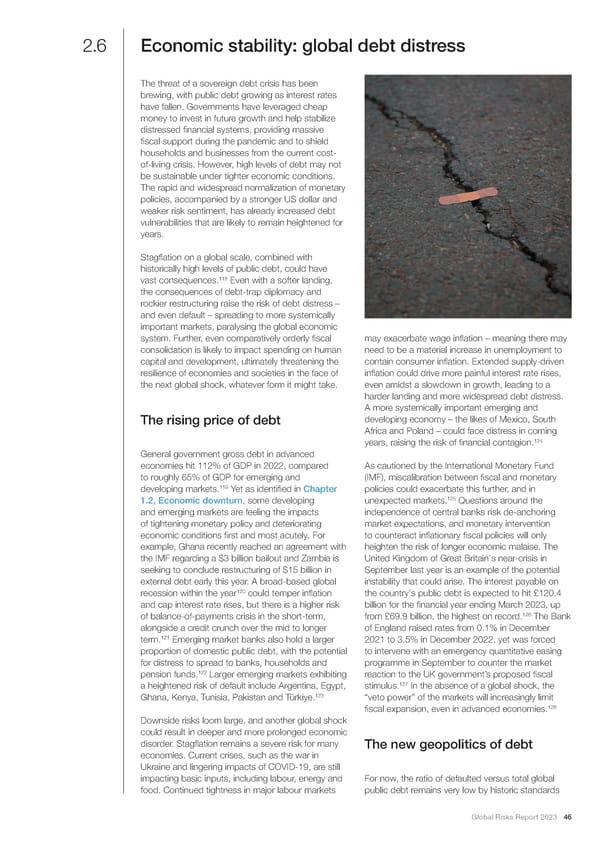2.6 Economic stability: global debt distress The threat of a sovereign debt crisis has been brewing, with public debt growing as interest rates have fallen. Governments have leveraged cheap money to invest in future growth and help stabilize distressed 昀椀nancial systems, providing massive 昀椀scal support during the pandemic and to shield households and businesses from the current cost- of-living crisis. However, high levels of debt may not be sustainable under tighter economic conditions. The rapid and widespread normalization of monetary policies, accompanied by a stronger US dollar and weaker risk sentiment, has already increased debt vulnerabilities that are likely to remain heightened for years. Stag昀氀ation on a global scale, combined with historically high levels of public debt, could have 118 vast consequences. Even with a softer landing, the consequences of debt-trap diplomacy and rockier restructuring raise the risk of debt distress – and even default – spreading to more systemically important markets, paralysing the global economic system. Further, even comparatively orderly 昀椀scal may exacerbate wage in昀氀ation – meaning there may consolidation is likely to impact spending on human need to be a material increase in unemployment to capital and development, ultimately threatening the contain consumer in昀氀ation. Extended supply-driven resilience of economies and societies in the face of in昀氀ation could drive more painful interest rate rises, the next global shock, whatever form it might take. even amidst a slowdown in growth, leading to a harder landing and more widespread debt distress. A more systemically important emerging and The rising price of debt developing economy – the likes of Mexico, South Africa and Poland – could face distress in coming 124 years, raising the risk of 昀椀nancial contagion. General government gross debt in advanced economies hit 112% of GDP in 2022, compared As cautioned by the International Monetary Fund to roughly 65% of GDP for emerging and (IMF), miscalibration between 昀椀scal and monetary 119 developing markets. Yet as identi昀椀ed in Chapter policies could exacerbate this further, and in 125 1.2, Economic downturn, some developing unexpected markets. Questions around the and emerging markets are feeling the impacts independence of central banks risk de-anchoring of tightening monetary policy and deteriorating market expectations, and monetary intervention economic conditions 昀椀rst and most acutely. For to counteract in昀氀ationary 昀椀scal policies will only example, Ghana recently reached an agreement with heighten the risk of longer economic malaise. The the IMF regarding a $3 billion bailout and Zambia is United Kingdom of Great Britain's near-crisis in seeking to conclude restructuring of $15 billion in September last year is an example of the potential external debt early this year. A broad-based global instability that could arise. The interest payable on 120 recession within the year could temper in昀氀ation the country's public debt is expected to hit £120.4 and cap interest rate rises, but there is a higher risk billion for the 昀椀nancial year ending March 2023, up 126 of balance-of-payments crisis in the short-term, from £69.9 billion, the highest on record. The Bank alongside a credit crunch over the mid to longer of England raised rates from 0.1% in December 121 term. Emerging market banks also hold a larger 2021 to 3.5% in December 2022, yet was forced proportion of domestic public debt, with the potential to intervene with an emergency quantitative easing for distress to spread to banks, households and programme in September to counter the market 122 pension funds. Larger emerging markets exhibiting reaction to the UK government’s proposed 昀椀scal 127 a heightened risk of default include Argentina, Egypt, stimulus. In the absence of a global shock, the 123 Ghana, Kenya, Tunisia, Pakistan and Türkiye. “veto power” of the markets will increasingly limit 128 昀椀scal expansion, even in advanced economies. Downside risks loom large, and another global shock could result in deeper and more prolonged economic disorder. Stag昀氀ation remains a severe risk for many The new geopolitics of debt economies. Current crises, such as the war in Ukraine and lingering impacts of COVID-19, are still impacting basic inputs, including labour, energy and For now, the ratio of defaulted versus total global food. Continued tightness in major labour markets public debt remains very low by historic standards Global Risks Report 2023 46
 2023 | Global Risks Report Page 45 Page 47
2023 | Global Risks Report Page 45 Page 47